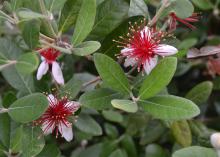Pineapple guava is delicious delight in gardens year-round
There are a few plants that bring both beauty and function to the landscape, and pineapple guava is one of those rare gems that does it all.
During a recent visit to Paul and Donna Ingram’s garden in Vicksburg, Mississippi, I was inspired by how beautifully they’ve showcased this remarkable plant. Their mature pineapple guava shrubs were in full bloom and absolutely thriving.
These plants made such an impression on me that I recently added a pineapple guava to my own landscape. These plants offer visual interest year-round while also contributing something useful.
Pineapple guava, known scientifically as Acca sellowiana, is an evergreen shrub or small tree that is native to South America. It is known for its versatility. Depending on growing conditions and how it is pruned, the plant reaches 6 to 15 feet tall and wide.
You can shape it as a small tree, let it grow naturally as a large shrub or even train it as a hedge or espalier. It’s also quite happy growing in a large container, performing well in areas where space is limited.
What first drew me in was its foliage. The thick, leathery leaves are gray-green on top with silvery undersides. These shimmer beautifully in the light, adding a soft, almost frosted texture to the garden.
In late spring to early summer, pineapple guava puts on a show with clusters of unique, edible flowers. Each bloom features fleshy white petals with a hint of pink and a burst of crimson red stamens at the center. I’ve found the petals to be a lovely treat, mildly sweet with a faint hint of spice. They are delicious tossed into salads or enjoyed fresh off the plant.
By early to mid-fall, pineapple guava produces egg-shaped, green fruit that are delightfully fragrant and flavorful, like a blend of pineapple, mint and guava. These drop when ripe, so keep an eye out beneath the plant once fruiting begins.
The fruit can be scooped out and eaten fresh or used in recipes like smoothies, jams, chutneys or baked goods. Some gardeners even dehydrate the slices for a chewy, tropical snack.
This plant is surprisingly easy to grow.
Pineapple guavas have the best flowering and fruiting in full sun, but they also tolerate partial shade. Well-drained soil is a must, as soggy conditions can lead to root rot. Once established, it is fairly drought tolerant, though regular deep waterings during dry spells help to encourage strong growth and fruit production.
I recommend feeding pineapple guava with a balanced, slow-release fertilizer in early spring and again in midsummer to support flowering and fruit set. While it doesn’t need much pruning, you can lightly shape the plant after flowering to maintain its form and to remove any crossing or crowded branches.
In my U.S. Department of Agriculture plant hardiness zone 8b, pineapple guava is reliably hardy and tolerates brief dips in temperature into the upper teens without much trouble. In gardens further north, it is a good candidate for container growing and overwintering indoors or in a protected spot.
With its ornamental foliage, striking edible flowers, tasty fruit and ease of care, pineapple guava is a standout in Paul and Donna’s garden. It is also a wonderful choice for anyone looking to blend aesthetics with practicality, and it never fails to spark conversation when guests stop by.





